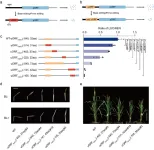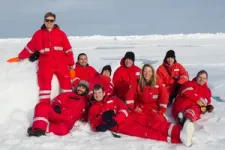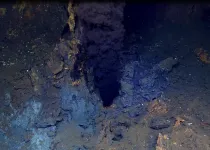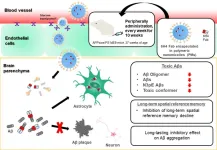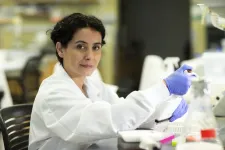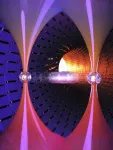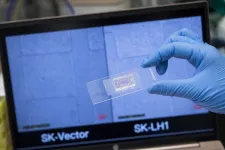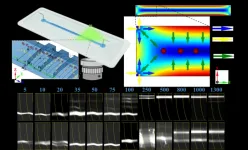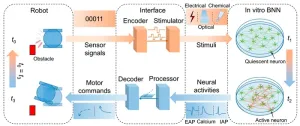(Press-News.org)
GAO Caixia's group from the Institute of Genetics and Developmental Biology of the Chinese Academy of Sciences (CAS) has developed a new method of downregulating gene translation to a predictable and desired level in plants by precisely engineering upstream open reading frames (uORFs).
The study was published online in Nature Biotechnology on Mar. 9.
The development and application of genome editing in plants has revolutionized molecular design-based crop breeding. Developing methods for fine-tuning gene expression based on precise genome changes is crucial for breeding new and desired traits into crops. Widely used gene editing tools such as CRISPR-Cas, CRISPR interference and RNA interference generally completely prevent gene transcription or reduce it to a defined but unpredictable level.
CRISPR-Cas9-driven mutagenesis of promoters provides a method for generating quantitative phenotypic changes at the transcriptional level and producing a wide range of gene expression levels. A method for predictably and incrementally regulating endogenous gene expression at the translational level would further expand on methods of controlling gene activity.
In 2018, GAO's group led the development of an efficient and tunable method for upregulating protein expression by knocking out endogenous uORFs. In 2020, they applied this technology to the genetic improvement of strawberries, generating a variety of new strawberry germplasms with different sugar content.
uORFs are important and universal cis-regulatory elements in eukaryotes that are thought to be associated with reduced mRNA translation. Many factors, such as uORF length and the distance between uORFs and primary open reading frames (pORFs), affect the inhibitory activity of uORFs. Therefore, the researchers proposed two strategies for downregulating gene translation: introducing de novo uORFs at the 5' untranslated region (5' UTR) of a target gene and mutating stop codons of endogenous uORFs to extend their coding sequences and enhance their inhibitory ability.
Dual-luciferase and western blot assays in transient systems showed that the newly produced and extended uORFs downregulated LUC/REN activity ratios to 9.5-86.9% of wildtype levels but had no effect on LUC/REN mRNA levels, thereby demonstrating translational control.
Using precise genome editing technologies such as base editors and prime editors, the researchers obtained mutant rice plants carrying new and extended uORFs. They then confirmed that the effects of these engineered uORFs on phenotypes and protein expression levels were the same as those observed in the transient reporter system.
To incrementally downregulate the translation of genes, the researchers combined the above approaches and generated a series of uORFs with different inhibitory capacities at the 5' UTRs of OsTCP19, OsTB1 and OsDLT. Transient systems showed that these uORFs incrementally downregulated the translation of pORFs to 2.5-84.9% of the wildtype level.
In addition, by editing the 5' UTR of rice OsDLT, which encodes for DWARF AND LOW-TILLERING—a member of the GRAS family of transcriptional regulators involved in the brassinosteroid (BR) transduction pathway—they obtained a range of plants with different BR sensitivity, plant height and number of tillers that matched the corresponding reduction in OsDLT levels observed in a transient protoplast assay.
By engineering uORFs, the researchers have developed an efficient and widely applicable method for downregulating gene translation to predictable and desired levels in plants, which will greatly improve future crop breeding.
This study was supported by grants from the National Key Research and Development Program, the Strategic Priority Research Program of the CAS, and the Ministry of Agriculture and Rural Affairs of China.
END
Deep down in the ocean at tectonic plate boundaries, hot fluids rise from so-called hydrothermal vents. The fluids are devoid of oxygen and contain large amounts of metals such as iron, manganese or copper. Some may also transport sulfides, methane and hydrogen. When the hot water mixes with the cold and oxygenated surrounding seawater, so-called hydrothermal plumes develop containing smoke-like particles of metal sulfide. These plumes rise hundreds of meters off the seafloor and disperse thousands of kilometers away from their source. Hydrothermal ...
This type of automated sorting would allow prioritisation of malignant slides so that pathologists can review them first and reduce the time to diagnosis for patients with cancer.
The final model was able to correctly detect 97% of malignant slides and correctly detect 90% of all slides.
The final model is in two stages. Firstly, the very large images are split into smaller patches and a deep learning model is trained to classify each patch as malignant or not.
Next, a second stage model combines the small patches back together and predicts a classification ...
Researchers led by Tokyo Medical and Dental University (TMDU) find that antibody fragments encapsulated in nanomicelles cross the blood–brain barrier and reduce the levels of toxic Aβ species in the brain of an Alzheimer’s disease model mouse
Tokyo, Japan — Sometimes the best things in life come by chance, when we happen to be in the right place at the right time. Now, researchers from Japan have found a way to ensure that new medications are delivered to the right place in the body and at the right timepoint in disease progression, so that they have the best effect.
In a study published recently in the Journal ...
CHICAGO – Today, the Species Survival Commission (SSC) of the International Union for Conservation of Nature (IUCN), the world’s largest conservation organization, announces that two iconic Chicago institutions - Shedd Aquarium and The Morton Arboretum - have been named as Centers for Species Survival. These new designations elevate the role of the Chicago region as an international leader in biodiversity conservation. What’s more, the two Centers will give the aquarium and the arboretum the opportunity to collaborate on conservation efforts, advancing projects that highlight the importance ...
University of Virginia scientists have identified a promising approach to delay aging by detoxifying the body of glycerol and glyceraldehyde, harmful by-products of fat that naturally accumulate over time.
The new findings come from UVA researcher Eyleen Jorgelina O’Rourke, PhD, and her team, who are seeking to identify the mechanisms driving healthy aging and longevity. Their new work suggests a potential way to do so by reducing glycerol and glyceraldehyde’s health-draining effects.
“The discovery was unexpected. We went after a very well-supported hypothesis that the secret to longevity was the activation of a cell-rejuvenating ...
WASHINGTON —In many baseball-obsessed countries like Korea, Japan and the United States, with spring months comes the start of the season and quite a few balls flying through the air. But it’s not just balls that can be thrown. On the tiniest field imaginable, scientists have now shown they can also throw and catch individual atoms using light.
This amazing feat was achieved with optical traps, which use a highly focused laser beam to hold and move tiny objects. Although optical traps have been used to move individual atoms before, this is the first time ...
At this year’s American Academy of Orthopaedic Surgeons (AAOS) Annual Meeting, held March 7 to 11 in Las Vegas, Hospital for Special Surgery (HSS) presented new research on a variety of topics in orthopedic surgery, including studies related to minimally invasive surgery, racial disparities, and opioid alternatives for pain management in spine care.
What follows are some highlights from the meeting:
Intravenous versus Oral Administration of Acetaminophen Perioperative to Instrumented Lumbar Fusion: A Single-Center, Randomized Controlled Trial
In patients undergoing ...
Cancer metastasis is a major cause of cancer-related death. A research team at City University of Hong Kong (CityU) recently identified a protein that triggers the migration of liver and pancreatic cancer cells and metastasis, and is correlated with shortening the survival time of patients. The research findings were verified by in vitro and in vivo models, supported with clinical data, and are expected to provide a new potential target for cancer therapy.
“Cancer metastasis is a complex process. Stiffness in tumours and the surrounding tissues is known to increase along with the tumour growth, which creates confined spaces or channel-like tracks of pores for tumour ...
A research paper by scientists at the Hebei University of Technology and Shenzhen University developed an on-chip viscoelasticity sensor for biological fluids.
The new research paper, published on Jan. 10, 2023 in the journal Cyborg and Bionic Systems, reported a double-layered microfluidic sensor to detect the ultra-weak viscoelasticity in biological fluids.
“Most of human body fluids are non-Newtonian liquids, and the influence of viscoelasticity is often ignored for the sake of simplification of analysis. However, we ...
A review paper by scientists at the Beijing Institute of Technology summarized recent efforts and future potentials in the use of in vitro biological neural networks (BNNs) for the realization of biological intelligence, with a focus on those related to robot intelligence.
The review paper, published on Jan. 10 in the journal Cyborg and Bionic Systems, provided an overview of 1) the underpinnings of intelligence presented in in vitro BNNs, such as memory and learning; 2) how these BNNs can be embodied with robots through bidirectional ...
